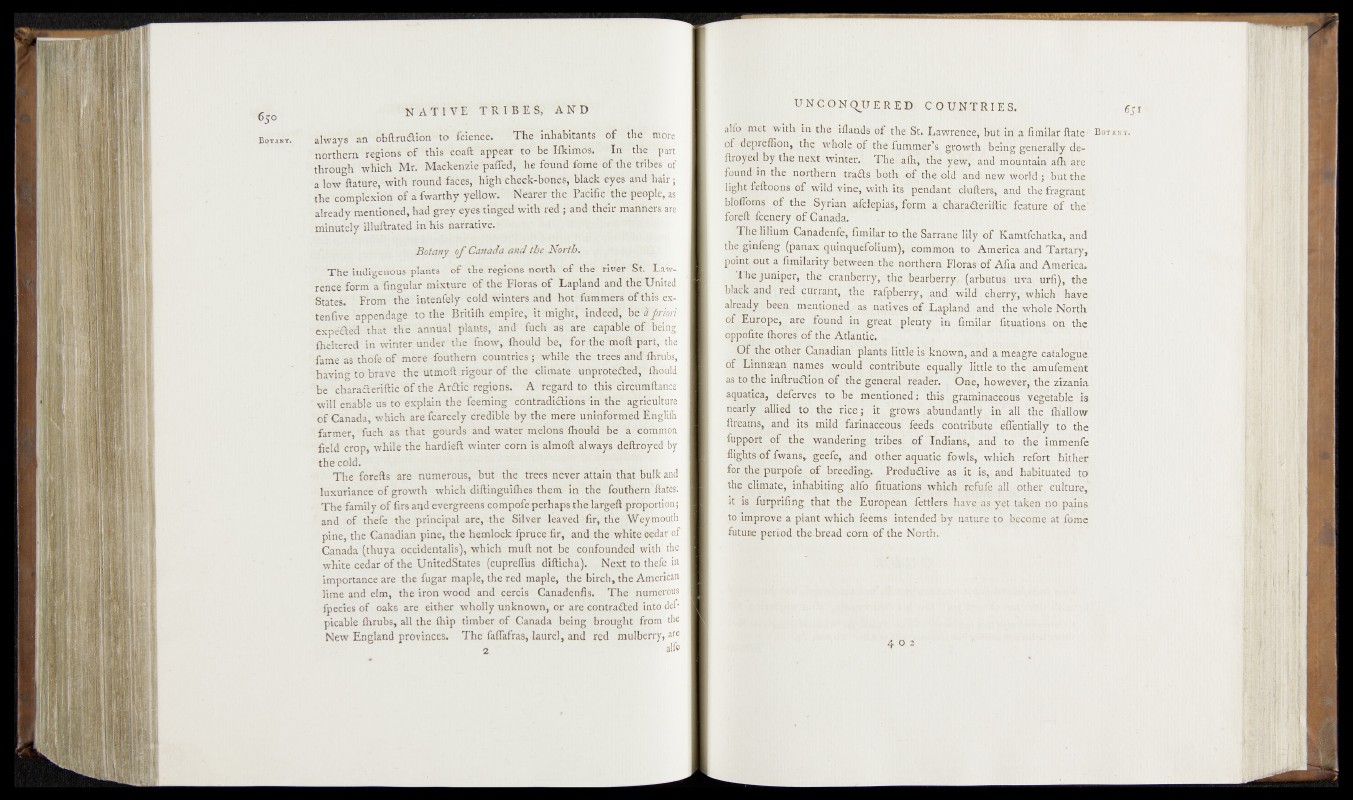
fiyo N ATIVE TR I BE ffî AND
B otany. always an obftrvnaioh- to fciencfe. The inhabitants of theNn&re
tibrthérn1 ; régions MflMj 'coaft appear to be ïfkimOs. In the pvart
through which Mr. Mackenzie puffed, he fonna iome cff'Öie'tnbes®
alow ftaturé, with round faces, high cheek-bones, ’ blaiJk eyes-altd hair;
the cofnplexiöö of i fwarthy yellbw. ' Nearer the Eafcific the fëople, as
already mentioned, had grey eyes tinged with red ; and their mhfhers|re
minuthly iUidteated|*|his narrative. |j n
I I • ïMatq&y of Canada end the a i
T h e indigenous plants of the regions'nbrth'of the river St. ' Lawrence
form a fmgular mixture of the Floras-of Lapland and the Wiited
"States. From the intenfely cold winters and hot" fummèri of this p:-
tenlive appendagë to the Britifb empfeb,* it might; ïnJ^fÇ Wra/ns«
expected that the annual plants, and fucfr as'“are^caplb1e|Bfp)eing
fhfeltered in winter under the fnow, fhould be,'* for 'the ‘tooft' 'part, i p
fame as thofe of moré fouthern countries; while the-trees-and fibrils,
having td brave the utmoft rigour of the climate H^|ld
be charâÆtenttic of the Arctic regions. A regard tö this'mcrarptatice
will enable us to explain the feeniirigWntradrâièri^ffitl^^^'ulpre
of Canada, which arefcarcely credible by the merehriinforrifed Èndïïh
farmer fuch as that gourds and water melons fhould be
field crop, while the bardieft winter corn is àhüoft always jdèftroyed by
thfecold.
The forefts are numerous, but the trees never attain5 that bblkgtnd
luxuriance of growth which diftinguifhes them’ in the ' fotfffiern ftates;
The family of firs and evergreens compofe-perhaps the largéft proportion;
and of thefe the principal are, the Silver leaved •’fir, the Weymouth
pine, the Canadian pine, the hemlock fpruce fir, and the wh^lfedar of|
rtanada (thuya. occidentalis), which muff not
white cedar of the UnitedStates (cupreffus difticha). Next Ipjlteïe in
importance are the fugar maple, thé red maple, thé birch, the American
lime and elm, the-iron wood and cercis Canadenfis. The nüôierous
fpecies of oaks are either wholly unknown, or are contracted into del*
picable fhrubs, all the fhip timber of Canada being brought? f rom ! the
New England provinces. The faflafras, laurel, and red mulberry, are
2
n Ip G'° N W|E R E D c ®W m - Si ' 6s i
al£p,fnet St.*Lsv^rjenpef}Hut in a fimilar ftater|$3<>TANY.
0 %tn^i ^owth ielig genfir^Hv de-
|Plf ^ujtdr.i T&pafb| mountain afh ^jce
found & the ^Whe^,: but the 1
its.,jp£h^^j;v,(Jliiijl;ciis} arpl the ■
blbffoms of tbfiliSl^^n^afoj'epi^s, for|n. ^‘c^|^|1rifl:ic’r feature of th[c*’'t
fo^ y flenerv bf Canada.'
Theliliiim Canaden4 |#milar Vdy of Kamtfchatka, aA&
the? glnfeng (panax quinquefolium), common ao ^Am^rifc’a^hd Tkrtady,'
poM?to a^fimilayitwbefweerujthe noifoerp
1 he juniper, the jO^Bpqrry, tK&itek^^r^^arbutpsiyj^^jurfiL^ «fee.1 ,
fa^<|j|jt$|(d t cher^||^hjiJ|i haye
<M § ||P% arejfegrf: Mj^reat plenty , ip fv8*MiWvy i t , 'tfe..
taH MEIfliores ofAe Atlantic.'!*
JDf^the ot^er Canadian p(alrts. 1 ittIsis'jk n 0 w n, ^a nil a jineagre (eataf&pe.*
Lhinaan monies jwould ,^nfi?ibute .equally' ^tlo to*tfe:.amtlfetpej|.t
as to the inftrudiion dc thp general reader. . One ' lioy^.veE^«be!^zanja
aquatica, .d^ryes to be pfeptioned': fhis^gram^SnaMouS^Mraapfe is.
allied to the .« |k i. abuildantlv . ,|lmU!me^MaTow
ftreah^. .and‘its-mild farinaceous feeds coStriKutgf pfleritiallly S|.t\e
?f the 'wandering tribes' .of Indians, ^ »to*».the^ fmmenfe.
fifgMp ° f fwans, geelA and o(ther aquatid fowls, which remrt_ hither
forto purpofe ^reeding, ' ProdlnSiye as 5itf .‘isii and habituated to
the llhnate, inhabiting alfo fituationls wfich'!fefujp alf/ffther^ cultured
it is furprifing that th.e European iettlers hSsve?a§ yet1 taken nopains
tMimprbve a plant which feems intended by nature to beoome^at firme
futuae period the bread co-rn of the North-.
40 2